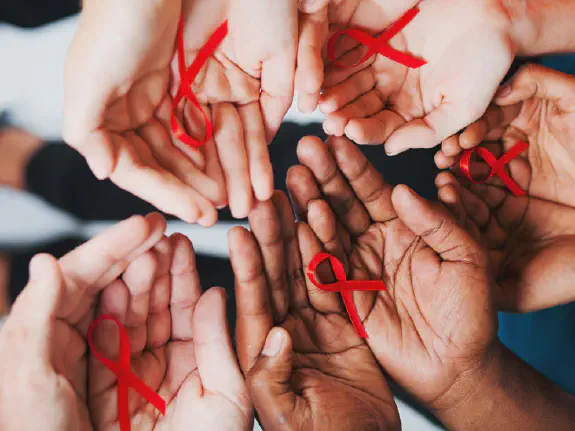Sex and Gender-based Analysis of this topic
Definition
Human Immunodeficiency Virus (HIV) is a virus that attacks cells of the immune system, which can result in chronic illnesses leaving people vulnerable to infections and cancers. When the body can no longer fight infection, Acquired Immunodeficiency Syndrome (AIDS) develops, which is a combination of symptoms and diseases. On average, it takes more than 10 years to progress from HIV infection to AIDS[1]. It is estimated that at the end of 2005, there were approximately 58,000 people in Canada living with HIV and AIDS, a 16% increase from 2002 figures[2]. It is estimated that approximately one-third of those infected are unaware of their HIV status[3]. Women account for an estimated 11,800 of these cases, which is 20% of the national total.
Sex Issues
Women represent an increasing proportion of positive HIV reports in Canada. Heterosexual contact and injecting drug use (IDU) are the main risk factors for HIV infection in women[4]. HIV transmission from male-to-female is two times higher than female-to-male via heterosexual contact[5]. Compared to men with HIV, women with HIV are more likely to: be infected by multiple variants of the virus, which will affect the type of treatment that will be effective for women; develop AIDS even though their levels of CD4 lymphocyte immune cells are higher than the recommended levels for treatment; and experience significant drops in body weight. As well, women with HIV are at increased risk for infection with human papilloma virus (HPV) and cervical cancer[6].
Gender Issues
Women are often diagnosed later in the progression of the disease and may have challenges in accessing care and/or treatment due to increased rates of poverty, which results in a lower survival rate compared to men. In addition, women are more likely to be exposed to abuse and violence, which may make negotiating safer sex behaviours or refusing sex difficult, putting them at higher risk for HIV infection[7]. Researchers are developing more effective female-controlled prevention tools, such as microbicides (topical substances, such as gels or creams), which help reduce the spread of HIV and sexually transmitted infections (STIs). However, presently, women lack an imperceptible female-controlled prevention method and may not be able to negotiate safer sex practices with their partners and require their partner’s consent and compliance when using prevention methods, such as a male or female condom.
Diversity
Aboriginal people and persons from HIV-endemic countries continue to be overrepresented in Canadian HIV figures[8]. Aboriginal persons account for only 3.3% of the Canadian population, but account for approximately 12% of all HIV infections[9]. The infection rate for Aboriginals is 2.8 times higher than the infection rate for the non-Aboriginal population, with more Aboriginals receiving a diagnosis at a younger age. Specifically, Aboriginal women account for approximately 45% of new HIV infections while non-Aboriginal women account for approximately 19% of new infections. IDU is the most common mode of HIV infection in the Aboriginal population (53% versus 14% in the non-Aboriginal population), while infection due to heterosexual contact is similar to that in the non-Aboriginal population[10].
The infection rate among individuals from HIV-endemic countries is at least 12.6 times higher than among other Canadians. African and Caribbean women are at risk for infection and may have limited access to HIV/AIDS information, education, and services due to lower economic status, cultural and religious stigma surrounding HIV/AIDS, and rigid gender roles that do not support women’s rights to their bodies, in terms of safer sex behaviours[11].
Critique
In general, national surveillance data may understate the magnitude of HIV in Canada due to an inability to accurately calculate incidence and prevalence rates, reporting delays, underreporting, and changing patterns in HIV testing. As well, data are only reflective of individuals who have been tested, which may not be an accurate picture of HIV/AIDS infection in Canada.
